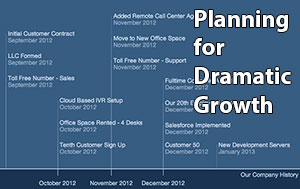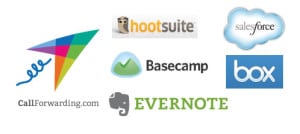Guide for Dramatic Business Growth in the New Year
How to achieve dramatic business growth in the new year. A comprehensive planning, marketing, and personal improvement guide for entrepreneurs.
1. Make a New Plan
It’s a great time to make a new plan and to get your business and personal life ready for the year ahead. Don’t start a 3-day planning exercise, you’ll never finish.
Instead of another failed effort to plan and start your future, read these steps below in 15 minutes, and get all these tasks started in week one, and fully implemented by week two.
1.1 Ask: Am I In The Right Business?
If you do have a good reason to be a business owner and have a goal in mind, next, consider the unthinkable – are you in the right business?
Perhaps your very first customer sale made it possible for you to open the doors, so to speak. Yet it’s possible that the first order sent you down a branch and not the “main trunk”. Think this through carefully – this is crucially important. Are you really positioned the right way, or is there a more profitable business right next to the one you own.
For example, if your company installs and maintains residential heating and air conditioning equipment, should your company also be installing water heaters and plumbing? Should your company also be doing residential electrical work? Perhaps you should be more a complete residential physical plant maintenance company. Same trucks, similar tools, similar work schedule and locations, similar staff.
Perhaps you started an SEO service, but now realize that most customers also want websites with full-service digital marketing behind it, including email marketing, landing page tuning, lead generation, SEO, PPC, and content marketing. Going down a narrow path with simple on-page tuning might have produced initial sales, but perhaps the broader market has more to offer.
1.2 Build an Exit Strategy
Starting with the end in mind, ask yourself “Why I am Doing This? Am I just building this business to make a few thousand a month for a few years?”
Before going further, decide if you want to be in business and if so, why? Is there something about growing your own company that is essential for your future self, or did you perhaps just let a hobby get out of control.
Some people start businesses without recognizing that the day-to-day task of finding customers, managing a team, and delivering services and products may not be as exciting or appealing as it seemed when they began. Perhaps you’d be happier as an employee in a better established business where you don’t have all the responsibilities that you do as a business owner, including some that you don’t enjoy. For example, if you only like doing in-depth analysis or building web sites, you may not like selling or not enjoy building your team.
If you are in business for the purpose of growing a business to secure your financial future, outline how that could conceivably deliver the money you want to have. How could you make your time and effort pay off? Are you going to sell your business? Are you going to have your employees buy you out? Start a list of three possible exit strategies, and search for articles and ideas on each. You’ll be overwhelmed with ideas and information, so after you’ve had time to consider the alternatives, get some professional money advice and pick a plan.
1.3 Establish Realistic Goals
With your exit strategy in mind, create measurable goals and dates when those goals will be reached, and start living your plan. Start recognizing distractions and deviations that you can trim off to ensure that your main goals are achieved.
Build your concrete set of goals and make them specific and measurable.
Don’t make this a four-day exercise or you won’t get this done. Make this a 1-hour exercise.
1.4 Make a Timeline
Don’t leave your new goals just hanging in air. Pin them down on a timeline by assigning a realistic date to each goal.
Print out your timeline and track against it. A simple list in Excel is fine, or use a fun tool like Timeline 3D if you are a tool nut.
Either way, get your goals and timeline on paper, and track it every week.
2. Improve Your Marketing
Most small companies suck at marketing.
The few winners do a great job with simple tools and processes. Good marketing is less difficult than changing a tire, but many companies just don’t organize it as an intentional and purposeful activity. If you have a plan and a purpose for your marketing, the results will bring in the sales dollars you need to grow. Here are a few ideas for the new year.
2.1 Hire an Experienced Marketing Agency
Ask friends and associates for recommendations, look at online ads, visit web sites, and make a list of three or four local marketing agencies who can help with your website and digital marketing including your branding, SEO, PPC, email marketing, landing page development, campaign planning, advertising, lead generation, conversion rate optimization, customer retention, and web analytics.
Choose an agency that understands your business and that is willing to communicate with you 24 hours a day. There’s nothing more important than having an experienced digital marketer who is on your side of the table and who “picks up the damn phone”. Agency size is not important, it’s the experience and communications that make it possible for any agency to help you, to adjust quickly to new plans, and to perform frequent deep-dives on your analytics data to help make new decisions in time to do some good.
Fancy presentations aren’t as important as good data and actual results like traffic, leads, sales, and campaign ROI. Perhaps one factor you can rely on as a differentiator is the agency’s skill with web analytics tools, it’s ability to interpret and explain your data, and to help you make actionable decisions from your data. This product or that? What time of day should we tweet? Are we missing India sales on Sunday nights? Are we missing any geographic areas that could be buying from us? Getting help with these questions is one of the most important areas where a good agency can help.
2.2 Track Your Marketing Campaigns Better
If only you knew which button to push to get new orders, you’d push it all day. So separate all your marketing activities into separate campaigns, and use cost-effective toll free numbers to provide dedicated tracking for each campaign. Use a general toll free number for your
Let toll free numbers separate out your sales and service traffic
2.3 Add New Customers and New Markets
If your service or product is in demand beyond driving distance from your office, why limit your sales to your neighborhood?
You can use Google Analytics or similar tools to see who visits your website, and then segment your visitor traffic by geography. Just from this, you’ll find that people in other regions are searching for the products and services you offer. They may not be buying only because you don’t appear to offer them
Look to add customers that you can support today. If you’re a English-speaking company and can provide services internationally or want to reach developing countries with lots of growth potential, consider adding customers in the US, Canada, the UK, Australia, South Africa, India, and Brazil as examples. You can get
- 1-800 numbers in the US,
- 800 numbers in Canada,
- UK local numbers,
- Australia Toll Free Number, and
- South Africa toll free numbers.
- Brazil Toll Free numbers
If you have Spanish-speaking team members, you can open up more markets in the Americas with Mexico toll free numbers as an example.
When you use toll free numbers including local telephone numbers (DID numbers) and country-wide toll free numbers (ITFS numbers) to reach those customers, you can have the calls forwarded to your existing business land lines, toll free numbers, or cell numbers for selected staff members. You can also get a virtual PBX with your toll free number, at no extra cost, so that your calls can be routed with “time of day routing” that you design.
3. Improve Your Delivery and Customer Service
Even if you’re a 3-person shop, you can improve your delivery, customer service, and customer retention with just a little effort to organize the activity, document it, track it, and tweak it based on feedback you get from your customers. Here below are a few ideas that can help.
3.1 Standardize Your Service Delivery
Whether you are running a dry cleaning store, a marketing agency, or a large industrial roofing supply distribution center, there are always deliverables. Not all the deliverables are profitable, and some types of deliverables that used to be “custom” are now being sold and provisioned for customers on a regular basis. So it’s a good time now at the beginning of the new year to re-package and standardize your deliverables so that you can make a profit on every customer sale and delivery, whether it’s a product, service, or combination of both.
Characterize your projects and jobs from the last three years, identify the projects as winners and losers, and for each, list what products and services you delivered. Write down how those were delivered, what each delivery contained, and how you built or delivered it. Look at the labor, supervisory cost, overhead assigned, and product cost of goods to estimate your actual cost for the deliverables in each project. Unless you are ignoring real costs, you should end up with some winners and some losers.
Condense your delivery experiences down and sort them out into standard packages that you can promise and deliver with the people and tools you have, and make a profit. Don’t be afraid to throw out and exclude some of the deliveries you’ve done in the past from your future offerings. Not every job is a winner, so it’s valuable to have those in your past history to help draw a line between what you do well and what you don’t.
The resulting set of standardized packages you select should be scalable. That means they shouldn’t depend on you for more than a handshake at the beginning of a deal. The rest of the piece parts should be work that you document “how to”, train your team to deliver, and track online as the deliverables are assembled.
3.2 Build a Customer Service Team
Build your customer service team around your product and service offerings. By looking at the packages of services and products you want to offer, you can sit with your team and write down the most common service issues you work for customers day-to-day. As always, 80% of the problems can be solved with the same 20% of solutions. So write out your problem handling or service providing steps for each of the most common requests or problems.
Make your service solution scalable by keeping your documentation online with a tool like Evernote, and using Google Docs for spreadsheet-based data needed for these solutions. You can leave links to your Google Docs in your Evernote notes.
In your documentation, make it clear who is responsible for each step in problem resolution, service provisioning, or product shipment. Don’t leave steps unassigned.
You can use a scalable CRM solution like Salesforce to do ticket tracking and to create a cross-account view of what’s happening in your customer accounts.
Get a toll free telephone number for customer service and track your customer service separately from sales and marketing.
Schedule a time to meet weekly with your customer service team. This could be an entire department, or it could just be you and one of your staff members, depending on the size of your business. Plan on reviewing each of the key customer service problems of the week, and use the time to update your documentation and to improve your processes.
Before the weekly meeting, reach out to customers with surveys or personal phone calls to find out how you are really doing. Ask for frank feedback and take action on improving your service.
3.3 Use Cloud Tools to Help Delegate and Manage Work More Effectively
You’ve read it 100 times – delegate, delegate, and delegate. As the legendary William Oncken once said, a mediocre next step by someone on your team today is better than a perfect move by you never. Target Excel spreadsheets that live only on your laptop computer, and contact lists that are only in your address book. Push them online and let your team get access to those documents and contacts. Then you can delegate the tasks that go with them.
Here are some wonderful tools that you can use to get tasks off your desk so someone in your team can get them done. These are cloud tools, which means that you can get to them anywhere, share with team members, and that you can access them by web browser or mobile device.
- Evernote – most wonderful tool for organizing task notes. Not to-do lists (although they have this built-in), these are notes in notebooks, where every note has the details you need to do a task. The location, date, previous meeting notes, a mechanical drawing, a chart, analytics results, attached PDF’s, or even a presentation. Whatever you need for a meeting or a task, you can store, tag, find, recall, and update in Evernote.
- Dropbox – Great online storage for customer delivery of large files.
- Box.com – online storage for your team. Like shared folders from the olden days when every department had a shared drive.
- Google Docs spreadsheets – Does your marketing team have a list of competitors? Move it to a Google spreadsheet so everyone can update it as you find new competitor information.
- Basecamp HQ – Easy to use tool for creating and assigning tasks to your team, and tracking progress. Has space for discussions and calendars for deliverables.
- Cloud HQ – synchronize between each of your online services, from one to the next. For example, comments on customer tasks in Basecamp can be copied to one of your Evernote notebooks.
- Mailchimp and Constant Contact – examples of two popular email campaign programs you can use to bring visitors back to your site and to keep customers informed of new service offerings.
- Hootsuite, Buffer, and Sprout Social – Three great social media tools that support use by your team to promote your brand and content your marketing group develops to appeal to new customers. These tools are web-based and have handheld clients for your mobile devices, so that even if you marketing team members are on the road, your social media streams stay busy, attracting new customers.
- CallForwarding.com – A cloud-based virtual PBX lets you manage where calls are answered in your business, so that even if you are on travel, you can have key calls forwarded to your mobile device or to another team member.
For more ideas, see Bruce Brownlee’s Best Cloud Services for Startups.
3.4 Start Testing Marketing Campaigns
This year, make certain that you’re spending your marketing budget wisely. Measure and track your marketing expenditure and the revenues that can be attributed to that spending. Then test new campaigns and landing pages to find a way to maximize sales.
In marketing jargon, we’re talking about tracking your marketing spend and the campaign ROI for each of your marketing campaigns. A campaign can be as simple as a single email sent to existing customers, or as complex as a multichannel campaign with lots of landing pages, display ads, physical mail pieces, and a major event.
The first step is to start tracking campaign costs. You can do this with just an Excel or Google spreadsheet, or use an integrated digital marketing tool like Hubspot. Whatever tool you use, all that’s important is that you know your actual marketing spend, item by item.
The second step is to set up your analytics and reporting to attribute campaign sales to your marketing spending. It’s never possible to completely attribute all your sales revenue to individual marketing expenditures, but go as far as you reasonably can.
At this point you can calculate an ROI for each marketing campaign. Some campaigns are doing better, some have lower ROI numbers. Now what?
Next, use experiments of all types to start increasing the conversion rate on landing pages, to improve visitor engagement on your web site, to increase the response rate on emails, to reduce the bounce rate on your web site pages, to increase the clickthrough rate and conversions on your PPC ads, and to attract more organic search visitors to your web site.
Here’s where you use free or inexpensive tools to perform A/B testing (multivariate testing or split testing) on your landing pages, to generate heat maps or mouse click or mouse hover maps, or to perform other tests that will let you experiment to find ways to improve marketing ROI in your campaigns.
Here are a few examples of the many tools that can help you with testing and tuning landing pages to gain a higher conversion rate.
- Marketo – landing page construction and conversion tracking, lead nurturing
- Crazy Egg – heat maps to help you understand visitor behavior on your site
- Ion Interactive – landing page construction and conversion tracking
- Unbounce – landing page construction and conversion tracking
- Hubspot – landing page construction, email campaigns, campaign ROI tracking
- Optimizely – landing page optimization via A/B testing
- Google Content Experiments – A/B testing and multivariate testing
These aren’t the only tools, but as you search for these you’ll find others. The point is that after you’ve made the effort to drive traffic to your landing pages, improving your conversion rates on your landing pages to take advantage of the traffic you have generated.
3.5 Scale Up Sales Expectations
To get more sales you have to work on your sales. OK, that’s not meant to be prophetic, it’s just a fact. Things get better when you apply time and effort in an effective way. Things fall apart when you neglect them. So, to scale up sales, apply your time and effort and scale up sales expectations.
First, segment and analyze your existing sales and compare them to what your competitors appear to be doing. By using keyword research tools and other market data, you may be able to understand whether you are lined up on the most profitable parts of your market, or are missing the market.
Next, set more realistic quotas. Review your sales targets and try to find places where you should be setting higher expectations, based on new market opportunities, new tools, or new marketing efforts you’ll support. Where you’ve set unrealistic sales targets and individual quotas in the past, correct these targets and quotes to give every team member a chance to earn incentive pay. And if you find a role in your sales and marketing team that has no incentive component, restructure the job so it does. Everybody needs to be on commission in some way.
Install and use a CRM tool like Salesforce so that you can track leads, opportunities, and sales and attribute those to your marketing and sales activities. A web-based tool is ideal because it’s scalable, mobile friendly, and easy to manage. Don’t customize your CRM toll beyond ensuring that your landing page submits go directly into your CRM tool as leads. Otherwise, you’re better off to change your sales administration processes to work well with your CRM, than to change your CRM to match your sales processes.
After you get your CRM tool in place, even the nearly free basic version, use it to death. Get all the free training you and your staff can stand. Use free templates and quick start guides to get a solid set of forms and reports into production. Then work your CRM “like a rented mule”. Build simple online reports and dashboards, and set time aside to check them every day.
Let your new CRM help you celebrate your victories and share ideas and facts about failures. Sit with your team and go over big wins and big losses each week. Let your team members suggest and implement fixes and improvements, and praise and recognize initiative. Yes, that’s a bunch of platitudes, but doing the basics well will usually work well for you as you work to increase sales and profits.
4. Start Taking Better Care of Yourself
You know it’s a great day when you wake up feeling great, have a clear head, and start the day with a clear picture of what you want to get done. This is of course a rare day. Why is that so? Because entrepreneurs often work until 3am on getting customer deliveries out the door, then get up at 7:30 to be at the office for a 9AM call with another customer. Fast food for breakfast and lunch, no time for a workout after work, but warmed-up pizza for dinner and another 6 Diet Cokes, followed by donuts after midnight. By end of day, 18 hours are spent sitting in one chair or another.
This guarantees a highly-cafienated lifestyle, but also drastic weight gains over the next 20 years, Type 2 diabetes by age 50, super-high LDL and triglycerides, and a high likelihood of congestive heart failure, stroke, Alzheimer’s, and increased chance of cancer.
And the 24×7 focus on day-to-day deliveries may also take a toll on your personal finances. Without a plan in place, and funding flows to support it, you may work 40 years and end up with nothing to show for it – a pitiful retirement fund and little cash on hand.
So unless ending up sick and poor sounds like a good outcome for your life, you need to take care of yourself so you can help your business.
4.1 Improve Your Fitness and Life Expectancy
Was there ever a better time to recover your physical fitness than now?
Recent studies show that 30 minutes of exercise a day (40 is better) will drastically reduce your chance of getting Alzheimer’s, and improve your mental acuity and alertness today and in the future.
Studies also show that reducing your intake of sugars and other carbohydrates, eating nuts, and losing weight help you stave off the need for knee and hip surgery, stroke, heart attacks, and cancer. There are growing hints that low-fat foods do not improve health, and that your body does well on diets with a healthy amount of fats and protein and a much smaller amount of carbohydrates (breads, sugars, potatoes) than most people take on board today. So take the bread off your sandwich, eat the meat and lettuce, have some fresh fruit, and go ahead and have whole milk on your morning cereal.
4.2 Get Professional Help with Your Personal Finances
This year, get a CPA and separate financial planner, and work them hard to make a financial and tax plan for you and your family.
Major changes in Federal and state tax laws may take a bite out of your financial future unless you have a plan.
The financial plan you assemble will help you recalibrate your business exit strategy. The plan you should either help you build a comfortable retirement or protect you from running out of money even if you never plan to retire.
4.3 Save and Invest
Your money should work for you just as hard as you do for the money.
First, if you have personal debt, pay it off and never go into debt again except for a first mortgage on your primary residence. Consider the fact that the person who finances a new car every 5 years will, over a lifetime of $500 a month car payments, spend as much as $5 million on car payments.
Experts like Dave Ramsey suggest a simple plan. Set aside from 3 to 6 months of living expenses (not income, just expenses) in ready cash. A few thousand dollars in an ATM accessible savings account would work well, as an example. Next, pay off your consumer debts, one at a time, from smallest to largest. Do this by making minimum payments on all the debts except the one you are targeting. Live as cheaply as you can while reducing your debt. Ramsey says “no restaurant meals unless you’re working there”. For transportation, Ramsey recommends selling off your hugely expensive late-model cars and buying some clunkers until you can pay cash for a better car.
With personal debts retired, save a portion of your income each week and make monthly investments into a relatively safe low-maintenance investment such as a stock market index fund from Vanguard, Fidelity, Charles Schwab, or TIAA-CREF. Consider moving your checking and personal savings to a non-bank institution such as a local credit union or USAA.
If you’ve set up a 401K for everyone in your company that offers a match, make sure that you contribute as much as you can to earn all the match available.
4.4 Protect Yourself and Your Money
Do you have an umbrella insurance policy to protect you and your business? These are inexpensive and protect you from a host of hazards that could swamp your business and you personally in a sea of litigation. Errors and Omission insurance is available for businesses who develop customer deliverables, and that’s nearly all professional services businesses like software companies and marketing agencies.
If you are a good driver, it’s time to look for a top-rated auto insurance company with great policy service like AMICA. You’ll save money and get great customer service with a mutual company like AMICA, where the company is owned by the policy holders.
And it’s scary to ask, but is your will up to date? Have you assigned someone to make medical decisions for you in the unlikely event that an accident or unexpected illness suddenly sweeps you away? If you have a spouse or partner who you’d like to protect, you’ll want to have a will and medical directives that convey your wishes for how you and your estate will be protected.
You should have term life insurance in place to protect your family against the financial disaster that could ensue if you dies from accident or illness before building your estate. Similarly, long-term disability insurance is a great buy for most people, protecting against loss of income during your recovery from a serious accident or injury, as examples.
Finally, if you’re over 60, you should consider long-term care insurance as a source of financial coverage that could help you live independently longer after you retire. A long-term care insurance policy can pay for assistance that can enable to live at home instead of entering a nursing home. This can help protect your assets from the higher costs you might experience by moving to a nursing home. These may also help protect your assets against some of the confiscatory policies that require your estate to reimburse Medicare after you die.
4.5 Improve Your Personal Productivity
The decisions you make and your ability to implement those decisions are the only elements of your future success that you control Your personal productivity, and ability to avoid distractions, depends on your ability to focus, prioritize ruthlessly, communicate, and to finish work you’ve started.
To immediately improve your personal productivity, start with a resolution to be punctual. Be on time with everything. Join or start meetings on time. Ship customer deliverables as promised. Spend time with your family, but be on time for your customers, colleagues, team members, and family alike.
Next, learn to focus on just the important work at hand. Recognize and turn off distractions. When the conversation is on work, be a good listener, but keep it to the point. When the conversation turns to sports or politics, bring the conversation back to business or move on. Turn off televisions and radios unless you are reviewing media for your work. Studies show that a television in your office will double the amount of time that it takes for you to complete an assignment.
At the office, recognize “upward leaping monkeys” reaching for your back, and knock the little tasks back to the people who raise them as needs or issues. Stop getting behind in other people’s work. Instead do your own work. The fastest completion on a task can be accomplished by the person who raises the issue, so when a team member says “we need a new tool for managing all these WordPress sites”, assign that team member to test and select the best tool and get it set up. Don’t say the four deadly words “I’ll check into it”. A task done reasonably well by a staff member, this week, is far better than a perfectly done task by you, never.
Find an audio to the very best management lecture ever given – Managing Management Time by William Oncken is perhaps one of the best management papers every written. If you are fortunate enough to track down an audio of the 45 minute lecture by William Oncken, you’ll hear the most entertaining one-hour management story ever told. This includes learning how to spot those upward-leaping monkeys trying to get on your back. You’ll also learn how to manage your time so that you can get your work done and enjoy time with friends and family like a normal human being, even as you lead your startup company to success. You can find a book and audio cassette on Amazon, with authors William Oncken and Ken Blanchard as The One Minute Manager Meets the Monkey.
5. Summary
There are many other areas that will demand your time in the coming year, but if you cover the essentials outlined here, you’ll have a best-ever year, enjoy dramatic business growth, and you’ll learn how to repeat this success for years to come.






